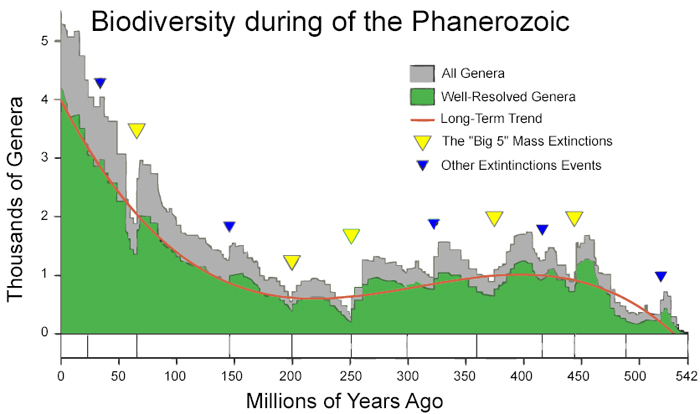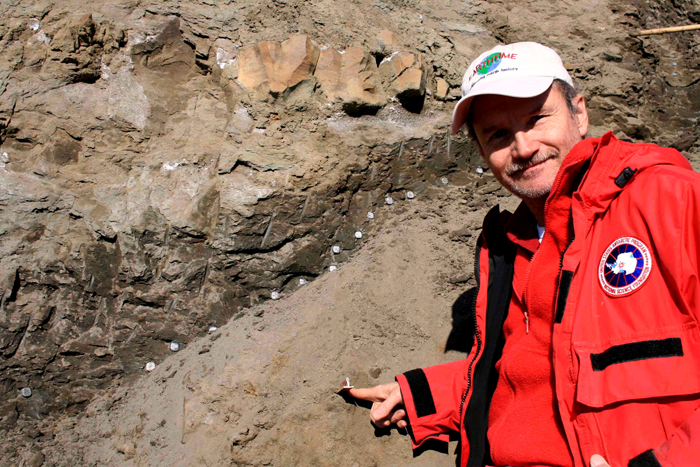|
What killed the dinosaurs?Scientists believe asteroid theory may not tell the whole story of KT extinctionPosted September 12, 2008
Dinosaurs, asteroids and death — mass extinctions don’t get more exciting than the most recent one of 65 million years ago. That’s when an asteroid slammed into the Earth, wiping out non-avian dinosaurs, but assuring them a starring role in a string of Hollywood epics. Known as the Alvarez hypothesis for the father-and-son team who published the paper in the journal Science in 1980, the theory suggests that the impact sent up a cloud of particles into the atmosphere, drastically cutting down solar energy and hence photosynthesis. Plants and marine algae withered and died, followed by the herbivores that munched on them, and reverberating up the food chain to the predators that depended on the plant-loving animals. Makes a great movie, and case closed, right? Maybe not. A science team led by paleontologist Peter Ward with the University of Washington in Seattle What Ward and his colleagues do suggest is that the planet was already on a downward spiral, an overheated greenhouse that was snuffing out life before the asteroid arrived. In boxing parlance, the asteroid didn’t deliver a first-round knockout but instead arrived at the match in round 12, after the planet’s biological life had taken a series of environmental blows. The extraterrestrial rock merely offered the final knockout punch, the coup de grace. “The evidence for there being an impact near the K-T boundary is extremely good,” conceded Joe Kirschvink, a geobiologist at the California Institute of Technology A murder mysteryThe scientists instead point to a major volcanic event that occurred roughly around the same time as the so-called Cretaceous-Tertiary extinction event, also known as the K-T extinction boundary. 
Graphic Credit: Wikipedia Commons
Biodiversity and extinction events over the last 500 million years.
The Deccan Traps in India represent one of the largest volcanic features on Earth. Formed between 60 and 68 millions years ago from a series of volcanic eruptions, the Deccan Traps consist of multiple layers of solidified flood basalt, a large area covered by basalt lava that today is about 2,000 meters thick, encompassing an area of 500,000 square kilometers. (The term traps comes from the Swedish word for stairs, referring to the step-like hills forming the landscape of the region.) The massive release of volcanic gases, particularly carbon dioxide, from the eruptions may have created a greenhouse effect, heating up the planet and stressing the giant dinosaurs and many other species to extinction. “It may have been one of those weird instances where the environment was deteriorating drastically because of the flood basalts, and then this impact bopped it all and did them in,” Kirschvink said. “In science, you try to find underlying principles that can explain many things. The impact hypothesis was once thought to be a universal explanation for all of these mass extinctions. “It’s one of these murder mysteries that scientists love to get tangled up in,” he added. Five major extinctions have occurred in the past 500 million years — the Ordovician, the Devonian, the Permian, the Triassic and the Cretaceous — as well as many minor ones. All of the big five except the K-T extinction appear to be greenhouse extinctions, according to Ward. “How can we say all of these other mass extinctions are associated with flood basalts — big flood basalts — and then right across K-T we have one of the biggest flood basalts in history of the planet, the Deccan Traps, but this one we say had no effect,” he said. “In other words, flood basalts cause extinctions every time except during the K-T. Hmm. Something is not right about this picture.” |
"News about the USAP, the Ice, and the People"



For USAP Participants |
For The Public |
For Researchers and EducatorsContact UsU.S. National Science FoundationOffice of Polar Programs Geosciences Directorate 2415 Eisenhower Avenue, Suite W7100 Alexandria, VA 22314 Sign up for the NSF Office of Polar Programs newsletter and events. Feedback Form |


